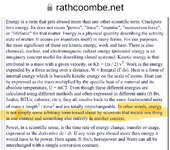I’ve heard this loosely parroted a few time across the web. “Energy is a useless number in terminal performance”. Is this a factual statement? Has the science been settled? Can its potential effect be so quickly deemed useless? Perhaps it is more misunderstood or unknown?
The purpose of this post:
1. A lively debate to the questions above.
2. To not spread possible misinformation either way on the matter, and to increase the knowledge base of this community. We know, we don’t know etc.
3. Come to some consensus through logical debate.
A few statements that we can hopefully agree on. Energy (in terms of projectiles fired out of center fire rifles) can only be increased by increasing a projectiles mass, velocity, or both mass and velocity.
Terminal ballistics is a sub-field of ballistics concerned with the behavior and effects of a projectile when it hits and transfers its energy to a target.
A few arguments to squash right off the bat that will quickly derail this discussion and get us off in the weeds.
These will fall under arguments that are not being made:
1. This is not an argument of whether or not the energy was necessary to kill an animal. If killing the animal was the only solution to the problem a sharpened stick would kill/answer the solution just as well as a nuclear bomb.
2. This is not an argument about bullet construction. This is a well known fact that bullet construction plays a huge part in the transfer of potential energy into the target.
3. This is not an argument solely about bullet diameter, bullet mass, bullet velocity, sectional density, or target medium as all have the potential to affect terminal performance. That is not in any particular order of importance.
4. This is not at all an argument that high energy always equals high terminal performance, but rather that higher energy has a higher potential to affect terminal performance. (More work that can potentially be done)
5. This is not an argument that energy figures should be held above or prioritized over any other variable. That being said no single factor should be held above all else as the extremes in any category seem to be where can problems arise.
6. Let’s agree to refrain from from using extreme hypotheticals or figures, I.e. 1 million foot pounds arguments. Let’s try to keep this within the available caliber/ mass/ velocity ranges current center fire rifles are capable of producing.
The purpose of this post:
1. A lively debate to the questions above.
2. To not spread possible misinformation either way on the matter, and to increase the knowledge base of this community. We know, we don’t know etc.
3. Come to some consensus through logical debate.
A few statements that we can hopefully agree on. Energy (in terms of projectiles fired out of center fire rifles) can only be increased by increasing a projectiles mass, velocity, or both mass and velocity.
Terminal ballistics is a sub-field of ballistics concerned with the behavior and effects of a projectile when it hits and transfers its energy to a target.
A few arguments to squash right off the bat that will quickly derail this discussion and get us off in the weeds.
These will fall under arguments that are not being made:
1. This is not an argument of whether or not the energy was necessary to kill an animal. If killing the animal was the only solution to the problem a sharpened stick would kill/answer the solution just as well as a nuclear bomb.
2. This is not an argument about bullet construction. This is a well known fact that bullet construction plays a huge part in the transfer of potential energy into the target.
3. This is not an argument solely about bullet diameter, bullet mass, bullet velocity, sectional density, or target medium as all have the potential to affect terminal performance. That is not in any particular order of importance.
4. This is not at all an argument that high energy always equals high terminal performance, but rather that higher energy has a higher potential to affect terminal performance. (More work that can potentially be done)
5. This is not an argument that energy figures should be held above or prioritized over any other variable. That being said no single factor should be held above all else as the extremes in any category seem to be where can problems arise.
6. Let’s agree to refrain from from using extreme hypotheticals or figures, I.e. 1 million foot pounds arguments. Let’s try to keep this within the available caliber/ mass/ velocity ranges current center fire rifles are capable of producing.


